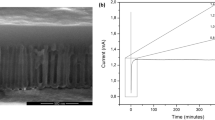Abstract
Superparamagnetic and flexible Fe2O3 nanowire arrays were fabricated by the controlled electrostatic assembly of iron oxide nanoparticles and poly(dimethyldiallylammonium chloride) (PDADMAC) in an anodic aluminum oxide (AAO) template. The micrograph of iron oxide nanowire arrays was characterized by field emission scanning electron microscopy. The magnetic hysteresis loops obtained by a vibrating sample magnetometer confirm that the nanowire arrays have superparamagnetic properties. The filling ratio of iron oxide nanoparticles and polymers in the AAO template was affected by four factors, including the concentration of iron oxide nanoparticles, the pore diameter of the AAO template, the charge ratio of iron oxide nanoparticles and PDADMAC, and the molecular weight of polyacrylic acid. The effect of the AAO template on the diameter and length of the nanowire arrays was also analyzed. In addition, the nanowire arrays were shown to be flexible because of the presence of polymers. These nanowire arrays with superparamagnetic and flexural properties have potential applications in sensor probes.







Similar content being viewed by others
References
Toufiq AM, Wang F, Javed QUA, Li Q, Li Y (2014) Hydrothermal synthesis of MnO2, nanowires: structural characterizations, optical and magnetic properties. Appl Phys A 116:1127–1132
Lee CH, Kim DR, Zheng Z (2011) Fabrication of nanowire electronics on nonconventional substrates by water-assisted transfer printing method. Nano Lett 11:3435–3439
Hong S, Lee H, Lee J, Kwon J, Han S, Suh YD, Cho H, Shin J, Yeo J, Ko SH (2015) Highly stretchable and transparent metal nanowire heater for wearable electronics applications. Adv Mater 27:4744–4751
Hong I, Angelucci M, Verrelli R, Betti MG, Panero S, Croce F, Mariani C, Scrosatie B, Hassoun J (2014) Electrochemical characteristics of iron oxide nanowires during lithium-promoted conversion reaction. J Power Sources 256:133–136
Liu X, Hua M, Wang Y, Liu J, Qin Y (2016) High sensitivity NO2, sensor based on CuO/p-porous silicon heterojunction at room temperature. J Alloy Compd 685:364–369
Selvarajan S, Alluri NR, Chandrasekhar A, Kim S (2016) BaTiO3, nanoparticles as biomaterial film for self-powered glucose sensor application. Sens Actuators B 234:395–403
Komathi S, Muthuchamy N, Lee KP, Gopalan AI (2015) Fabrication of a novel dual mode cholesterol biosensor using titanium dioxide nanowire bridged 3D graphene nanostacks. Biosens Bioelectron 84:64–71
Kumeria T, Maher S, Wang Y, Kaur G, Wang L, Erkelens M, Forward P, Lambert MF, Evdokiou A, Losic D (2016) Naturally derived iron oxide nanowires from bacteria for magnetically triggered drug release and cancer hyperthermia in 2D and 3D culture environments: bacteria biofilm to potent cancer therapeutic. Biomacromol 17:2726–2736
Goto H, Nosaki K, Tomioka K, Hara S, Hiruma K, Motohisa J, Fukui T (2009) Growth of core-shell InP nanowires for photovoltaic application by selective-area metal organic vapor phase epitaxy. Appl Phys Express 2:035004-03500-3
Kasai S, Asai T (2008) Stochastic resonance in schottky wrap gate-controlled GaAs nanowire field-effect transistors and their networks. Appl Phys Express 1:295–302
Koyama T, Hata H, Kim K, Moriyama T, Tanigawa H, Suzuki T, Nakatani Y, Chiba D, Ono T (2013) Current-induced magnetic domain wall motion in a Co/Ni nanowire with structural inversion asymmetry. Appl Phys Express 6:033001–033001–033001–033003
Su D, Ahn H, Wang G (2013) One-dimensional magnetite Fe3O4 nanowires as electrode material for Li-ion batteries with improved electrochemical performance. J Power Sources 244:742–746
Wei J, Zhao R, Zhan Y, Meng F, Yang X, Xu M, Liu X (2012) One-step solvothermal syntheses and microwave electromagnetic properties of organic magnetic resin/Fe3O4, hybrid nanospheres. Appl Surf Sci 258:6705–6711
Chang M, Wang W, Chung Y (2011) The one-step preparation of nanowires using a facile ultrafiltration technique: the case for biomedical chitosan and/or iron oxide nanowires. J Mater Chem 21:4966–4970
Cao X, Zhang X, Shao H, Feng Y (2014) Fabrication of magnetic Fe3O4, nanotubes by electrospinning. Rare Metal Mater Eng 43:2330–2334
Tadić M, Marković D, Spasojević V, Kusigerski V, Remškar M, Pirnat J, Jagličić Z (2007) Synthesis and magnetic properties of concentrated α-Fe2O3, nanoparticles in a silica matrix. J Alloy Compd 411:291–296
Yan M, Fresnais J, Sekar S, Berret JF (2010) Growth mechanism of nanostructured super- paramagnetic rods obtained by electrostatic co-assembly. Soft Matter 6:1997–2005
Yan M, Fresnais J, Sekar S, Chapel JP, Berret JF (2011) Magnetic nanowires generated via the waterborne desalting transition pathway. ACS Appl Mater Interfaces 3:1049–1054
Massart R, Dubois E, Cabuil V, Hasmonay E (1995) Preparation and properties of monodisperse magnetic fluids. J Magn Magn Mater 149:1–5
Bee A, Massart R, Neveu S (2015) Synthesis of very fine maghemite particles. J Magn Magn Mater 149:6–9
Berret JF, Sandre O, Mauger A (2007) Size distribution of superparamagnetic particles determined by magnetic sedimentation. Langmuir 23:2993–2999
Acknowledgments
This work was supported by the Program for Young Science and Technology Innovation Team of Sichuan Province (No. 2017TD0020), NSF of China (Grant Nos. 11304256 and 11505163), and the Project of State Key Laboratory Cultivation Base for Nonmetal Composites and Functional Materials (Nos. 14tdfk07 and 15zxfk10).
Author information
Authors and Affiliations
Corresponding author
Ethics declarations
Conflict of interest
The authors declare that they have no conflict of interest.
Rights and permissions
About this article
Cite this article
Zhu, X., Fan, J., Zhang, Y. et al. Preparation of superparamagnetic and flexible γ-Fe2O3 nanowire arrays in an anodic aluminum oxide template. J Mater Sci 52, 12717–12723 (2017). https://doi.org/10.1007/s10853-017-1383-0
Received:
Accepted:
Published:
Issue Date:
DOI: https://doi.org/10.1007/s10853-017-1383-0




